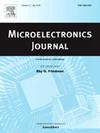片上集成0.4 GHz和2.3 GHz Lamb波谐振器:电极结构优化和翻转转移制造
IF 1.9
3区 工程技术
Q3 ENGINEERING, ELECTRICAL & ELECTRONIC
引用次数: 0
摘要
兰姆波谐振器在射频滤波器、红外探测器和传感器中显示出巨大的应用潜力。将底部电极转换成交互式换能器(IDT)结构允许更广泛的应用。然而,沉积在图像化idt上的压电薄膜往往存在质量差、开裂、退化或破坏谐振器性能的问题。本研究提出一种晶圆级翻转转移方法,将预先设定的压电振动和空腔结构翻转到另一个晶圆上。这颠倒了底部电极图案化和压电薄膜沉积的顺序,避免了上述问题。利用该工艺,将工作频率为0.4 GHz和2.3 GHz的Lamb波谐振器集成在8英寸晶圆上,同时具有IDT-IDT和IDT-Floating两种配置。此外,优化了电极参数,实现了多模耦合和抑制杂散信号。测试结果表明,当Sc掺杂量为9.5%时,工作在0.4 GHz和2.3 GHz频段的Lamb波谐振器的有效机电耦合系数(kt2)分别为2.87%和6.24%,质量因子(Q)分别为2547和1332。本文章由计算机程序翻译,如有差异,请以英文原文为准。
On-chip integrated 0.4 GHz & 2.3 GHz Lamb wave resonators: Electrode structure optimization and flip-transfer fabrication
—Lamb wave resonators show great potential for applications in RF filters, infrared detectors, and sensors. Converting the bottom electrode into an interdigitated-transducer (IDT) structure allows broader application. However, the piezoelectric film deposited atop patterned IDTs often suffers from poor quality and cracking, degrading or damaging resonator performance. This study presents a wafer-level flip-transfer method which flips the pre-defined piezoelectric vibration and cavity structures onto another wafer. This reversed the sequence of bottom electrode patterning and piezoelectric film deposition, avoiding the problem above. Utilizing this process, Lamb wave resonators operating at 0.4 GHz and 2.3 GHz with both IDT-IDT and IDT-Floating configurations were integrated on an 8-inch wafer. Furthermore, electrode parameters were optimized to enable the multi-mode coupling and suppress spurious signals. Test results indicate that, with 9.5 % Sc doping, Lamb wave resonators operating in the 0.4 GHz and 2.3 GHz bands achieved effective electromechanical coupling coefficients (kt2) of 2.87 % and 6.24 %, and quality factors (Q) of 2547 and 1332, respectively.
求助全文
通过发布文献求助,成功后即可免费获取论文全文。
去求助
来源期刊

Microelectronics Journal
工程技术-工程:电子与电气
CiteScore
4.00
自引率
27.30%
发文量
222
审稿时长
43 days
期刊介绍:
Published since 1969, the Microelectronics Journal is an international forum for the dissemination of research and applications of microelectronic systems, circuits, and emerging technologies. Papers published in the Microelectronics Journal have undergone peer review to ensure originality, relevance, and timeliness. The journal thus provides a worldwide, regular, and comprehensive update on microelectronic circuits and systems.
The Microelectronics Journal invites papers describing significant research and applications in all of the areas listed below. Comprehensive review/survey papers covering recent developments will also be considered. The Microelectronics Journal covers circuits and systems. This topic includes but is not limited to: Analog, digital, mixed, and RF circuits and related design methodologies; Logic, architectural, and system level synthesis; Testing, design for testability, built-in self-test; Area, power, and thermal analysis and design; Mixed-domain simulation and design; Embedded systems; Non-von Neumann computing and related technologies and circuits; Design and test of high complexity systems integration; SoC, NoC, SIP, and NIP design and test; 3-D integration design and analysis; Emerging device technologies and circuits, such as FinFETs, SETs, spintronics, SFQ, MTJ, etc.
Application aspects such as signal and image processing including circuits for cryptography, sensors, and actuators including sensor networks, reliability and quality issues, and economic models are also welcome.
 求助内容:
求助内容: 应助结果提醒方式:
应助结果提醒方式:


